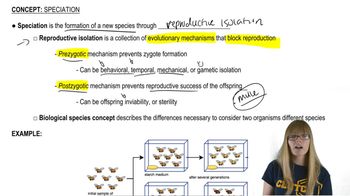In diploid yeast strains, sporulation and subsequent meiosis can produce haploid ascospores, which may fuse to reestablish diploid cells. When ascospores from a segregational petite strain fuse with those of a normal wild-type strain, the diploid zygotes are all normal. Following meiosis, ascospores are petite and normal. Is the segregational petite phenotype inherited as a dominant or a recessive trait?
Table of contents
- 1. Introduction to Genetics51m
- 2. Mendel's Laws of Inheritance3h 37m
- 3. Extensions to Mendelian Inheritance2h 41m
- 4. Genetic Mapping and Linkage2h 28m
- 5. Genetics of Bacteria and Viruses1h 21m
- 6. Chromosomal Variation1h 48m
- 7. DNA and Chromosome Structure56m
- 8. DNA Replication1h 10m
- 9. Mitosis and Meiosis1h 34m
- 10. Transcription1h 0m
- 11. Translation58m
- 12. Gene Regulation in Prokaryotes1h 19m
- 13. Gene Regulation in Eukaryotes44m
- 14. Genetic Control of Development44m
- 15. Genomes and Genomics1h 50m
- 16. Transposable Elements47m
- 17. Mutation, Repair, and Recombination1h 6m
- 18. Molecular Genetic Tools19m
- 19. Cancer Genetics29m
- 20. Quantitative Genetics1h 26m
- 21. Population Genetics50m
- 22. Evolutionary Genetics29m
2. Mendel's Laws of Inheritance
Inheritance in Diploids and Haploids
Problem B.9
Textbook Question
If a man and a woman are each heterozygous carriers of a mutation causing a disease on the RUSP list, what do you think are the three or four most important factors they should consider in their decision making about having children?
 Verified step by step guidance
Verified step by step guidance1
Understand that being heterozygous carriers means each parent has one normal allele and one mutated allele for the disease gene, which is typically autosomal recessive in nature.
Recognize that if both parents are carriers, there is a 25% chance with each pregnancy that the child will inherit two mutated alleles and be affected by the disease, a 50% chance the child will be a carrier like the parents, and a 25% chance the child will inherit two normal alleles.
Consider the severity and treatability of the disease on the RUSP list, including how it might affect the child's quality of life and life expectancy, as this impacts the decision-making process.
Evaluate available reproductive options such as genetic counseling, prenatal testing, preimplantation genetic diagnosis (PGD), or the use of donor gametes to reduce the risk of having an affected child.
Reflect on personal, ethical, and emotional factors, including family support, values, and readiness to manage a child with a genetic condition, as these are crucial in making an informed decision.
 Verified video answer for a similar problem:
Verified video answer for a similar problem:This video solution was recommended by our tutors as helpful for the problem above
Video duration:
2mPlay a video:
Was this helpful?
Key Concepts
Here are the essential concepts you must grasp in order to answer the question correctly.
Autosomal Recessive Inheritance
This inheritance pattern means that a child must inherit two copies of a mutated gene, one from each parent, to express the disease. Heterozygous carriers have one normal and one mutated allele and typically do not show symptoms but can pass the mutation to offspring. Understanding this helps assess the risk of having an affected child.
Recommended video:
Guided course

Autosomal Pedigrees
Carrier Screening and Genetic Testing
Carrier screening identifies whether individuals carry mutations for specific genetic disorders, such as those on the RUSP list. Genetic testing can provide information about the likelihood of passing the disease to children, enabling informed reproductive decisions and consideration of options like IVF with genetic diagnosis.
Recommended video:
Guided course

History of Genetics
Reproductive Options and Counseling
Couples with carrier status should explore reproductive choices including natural conception with prenatal testing, use of donor gametes, adoption, or assisted reproductive technologies. Genetic counseling offers guidance on risks, implications, and emotional support to help make informed decisions aligned with their values.
Recommended video:
Guided course

Speciation
Related Videos
Related Practice
Textbook Question
400
views


